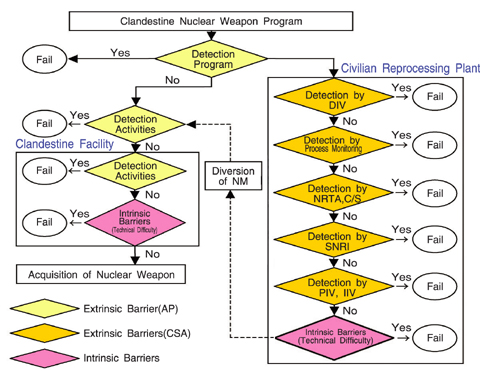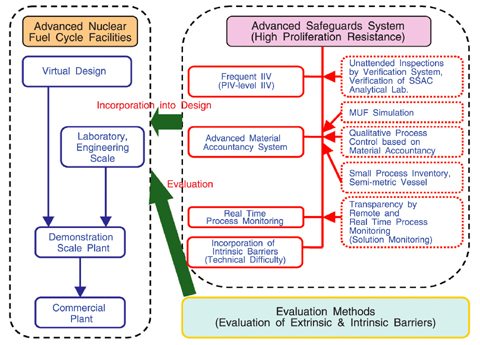
Fig.13-2 Proliferation resistance of future reprocessing plant (Extrinsic barriers, intrinsic barriers)

Fig.13-3 Incorporation of advanced safeguards system into design of NFC (Future reprocessing plant)
The demand for peaceful use of nuclear power is remarkably increasing, in particular in order to ensure global energy security and prevent global warming. A future nuclear fuel cycle (NFC) (i.e. fast neutron reactor fuel cycle) must recycle a much larger amount of plutonium than at present, which raises nuclear security issues (prevention of nuclear proliferation). In this context, for the future NFC, very robust measures for nuclear security, namely nuclear proliferation-resistance (PR), have to be taken in advance. A proliferation resistant NFC will impede diversion of nuclear materials by host states into nuclear explosive devices or other weapons. It is said that PR should be supported both by intrinsic features of nuclear energy system and extrinsic measures. International safeguards are very reliable and effective for early and timely detection of diversions of nuclear materials, but intrinsic features of the future NFC also have to be investigated at the same time to establish very robust nuclear security. We are developing reasonable PR measures (intrinsic features and extrinsic measures) for the future NFC. Here we explain briefly an example of our study results for a next generation reprocessing plant, including ways for improvement of technologies for detection of diversion (safeguards) and deterrence of diversion. Also, we summarize requirements for the future reprocessing technologies to have PR.
As proliferation threats, acquisition (diversion) of nuclear material by states, misuse of NFC facilities, withdrawal from NPT and theft of nuclear material by terrorist groups are mentioned. The effects of the extrinsic measures (extrinsic barriers) and intrinsic features (intrinsic barrier) on these threats are shown in Fig.13-2.
Extrinsic measures (IAEA safeguards), based on comprehensive safeguards agreement (CSA) and additional protocol (AP), are very effective for timely detection of diversion of nuclear material for clandestine weapon programs, because they establish many checkpoints. This is proved by the fact that so far no state which has entered into CSA and AP has attempted a clandestine weapon program. For realization of the future NFC with very heavy plutonium recycling, it is essential that extrinsic measures maintain high level detection capability.
To deal with the threat of a state's withdrawal from NPT or theft of nuclear material by terrorist groups, intrinsic features (technical & material barriers) are useful. The next generation reprocessing (advanced aqueous reprocessing) technology which is proposed in the FaCT project, features the requirement of technically difficult plutonium separation, due to minor actinide (MA) and fission product (FP) content in plutonium, making diversion less attractive. These intrinsic barriers are very effective for preventing a state from withdrawing from NPT.
We are proposing following requirements those make the future NFC technologies have higher proliferation-resistance, based on the results of our study. These requirements should be considered in designing the next generation reprocessing plant (Fig.13-3).
1. Frequent PIV (Physical Inventory Verification)-level IIV (Interim Inventory Verification); Implementation of frequent IIV close to PIV level in addition to PIV (once a year) in order to make MUF (Materials Unaccounted For) value low
2. Advanced nuclear material accountancy; Introduction of small process inventory based on semi-metric vessel procedures / Systemized material measurement / Creating quantitative modes for process control based on material accountancy
3. Real time process monitoring (Improvement of detection capability); Real time material accountancy with advanced solution monitoring / Detection of change of operation conditions (including acid content)
4. Incorporation of intrinsic barriers; Application of technology not readily capable of plutonium separation / Treatment resulting in less attractive plutonium mixed with MA and FP.
In order to establish a system concept of the future NFC which will be internationally accepted and has economic rationality, it is very important to combine extrinsic measures (safeguards) and intrinsic features properly. Also, explaining the concept to the world is important. For this purpose, it is necessary to participate in international non-proliferation activities such as INPRO and GEN-IV to set up internationally-accepted PR evaluation methodologies and PR norms.
In our study, so far we have investigated minimum conceptual requirements of proliferation-resistance. Hereafter, we need to investigate them in further detail.
<Previous: 13 Scientific & Technical Development for Nuclear Nonproliferation | Next: 14 Development of Experimental Techniques / Facilities at JAEA R&D Centers >